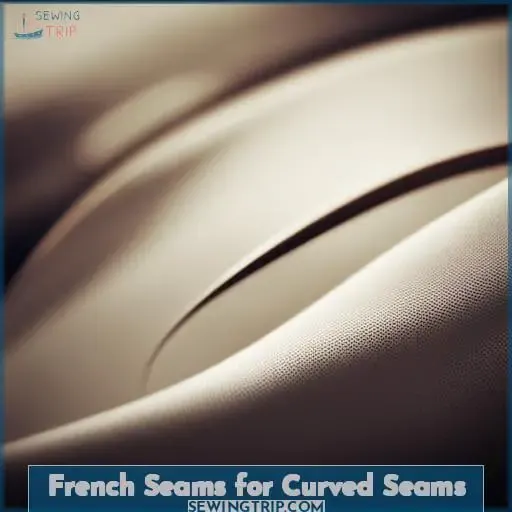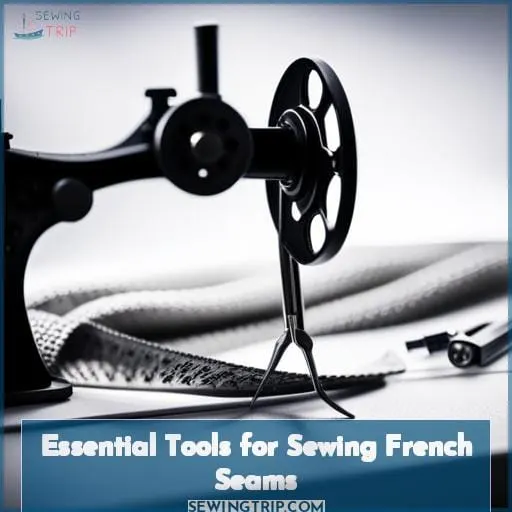This site is supported by our readers. We may earn a commission, at no cost to you, if you purchase through links.
 Imagine effortlessly sewing beautiful, professional-looking seams that give your garments a polished finish. With French seams, you can achieve just that! These cleverly constructed seams encase the raw edges within the seam itself, creating a neat and delicate result perfect for sheer or lightweight fabrics.
Imagine effortlessly sewing beautiful, professional-looking seams that give your garments a polished finish. With French seams, you can achieve just that! These cleverly constructed seams encase the raw edges within the seam itself, creating a neat and delicate result perfect for sheer or lightweight fabrics.
In this article, we’ll guide you through how to sew French seams step-by-step and when to use them in your sewing projects.
Table Of Contents
Key Takeaways
- Prevent fraying
- Create a neat finish
- Hide raw edges
- Provide durability
What Are French Seams?
French seams are a type of seam finishing where the raw edges of the fabric on the inside are completely enclosed in an extra row of stitching. This technique creates a strong and neat seam that’s ideal for lightweight fabrics, such as silk or chiffon, where fraying may occur.
French seams offer several advantages over other types of seam finishes. Unlike flat felled seams which have visible topstitching on both sides, French seams provide a clean and seamless look from both sides of the fabric.
They also eliminate any potential irritation caused by exposed raw edges. While they work best on straight seams, gentle curves can also be accommodated with some practice.
When it comes to specific fabrics, French seaming works well on delicate silks because it prevents fraying without adding bulk to the garment’s interior finish. These same qualities make them suitable for linen garments too—where excess fray often occurs—and even knits if handled carefully.
Denim pieces will benefit from this technique as well since denim tends to fray extensively along its cut edges.
French seaming provides not only durability but also adds elegance and finesse to your sewing projects.
How to Sew French Seams
Now let’s dive into the process of sewing French seams.
Start by pinning and stitching the seam with wrong sides together, using a 3/8 inch seam allowance.
Trim the seam allowance in half, then press it open to one side.
Fold the fabric with right sides together and stitch again using a 1/4 inch seam allowance, encasing the raw edge.
Finally, press the finished French seam to one side for a clean and professional look.
Pinning and Stitching the Seam
Once you have prepared your fabric, it’s time to start pinning and stitching the seam for sewing French seams.
- Pin the right sides together.
- Sew a 1/4-inch seam allowance.
- Press the seam open.
- Fold the fabric and stitch a second seam.
Trimming the Seam Allowance
To trim the seam allowance when sewing French seams, use fabric scissors to carefully reduce excess fabric.
Ensure right sides are together before trimming.
Trim the seam allowance to 1/8 inch for a clean finish.
Pressing tools can help create a sharp crease in the folded seam.
Pressing the Seam Open
Now, press the seam open using a pressing tool such as an iron or seam gauge. This step ensures a neat and professional finish for your French seams, flattening the raw fabric edges and creating a clean line.
Folding and Stitching the Second Seam
Now, fold the fabric with right sides together and stitch again using a 1/4 inch seam allowance, encasing the raw edge to complete the French seam.
- Align fabric edges precisely.
- Use a seam gauge for accurate measurement.
- Securely anchor your stitching at both ends.
- Trim any loose threads or excess fabric.
Final Pressing
Press the final seam to one side to complete the French seam.
Use a pressing tool, such as an iron, to press the fabric flat and ensure a crisp finish.
Follow proper pressing techniques and instructions for professional-looking seams.
When to Use French Seams
To determine when to use French seams, consider the type of fabric and the desired finished look.
French seams are particularly useful for sheer fabrics or delicate fabrics that tend to fray easily. They provide a clean and polished finish without any raw edges showing on the inside of the garment.
If you’re working with linen, which has a tendency to fray excessively, French seams can help contain those frayed edges and give your project a professional touch.
French seams are also great for straight seams on kids’ clothing as they add durability and prevent any puckering or unraveling that might occur over time. The neatness of these enclosed seam finishes ensures longevity in garments subjected to repetitive washing like pillowcases.
In summary, if you want your sewing projects to have an elevated level of sophistication while ensuring durability in delicate fabrics or preventing fraying in linen materials then incorporating french seems is highly recommended!
French Seams for Curved Seams
When sewing French seams for curved seams, it’s important to consider the limitations of this seam finishing technique.
While French seams are best suited for straight seams, they can be used on very gentle curves. However, if you’re working with sharp curves such as armholes or sleeves, it’s recommended to use alternative seam finishes like overlocking or bias bound seams.
French seaming curved edges can be challenging due to the nature of the fabric and its tendency to shift and pucker. Slippery fabrics pose a particular challenge as they require extra care and precision when stitching curved French seams.
Lightweight fabrics may also present difficulties as they’re more prone to fraying.
To overcome these challenges when sewing French-seamed curved edges, there are a few helpful tips:
- Use pins strategically along the curve before stitching.
- Take your time while sewing and make sure not to pull or stretch the fabric.
- Consider reinforcing delicate areas with stay tape or lightweight interfacing.
- Trim any excess bulk from inside corners carefully.
- Pressing is crucial in achieving smooth results; use pressing tools like tailor’s hams or sleeve rolls for shaping.
By following these guidelines and adapting your techniques accordingly, you can achieve beautiful French-seamed curves that add an elegant finish to your garments while preventing fraying and maintaining durability.
French Seams for Pillowcase Patterns
Let’s explore the benefits of using French seams for pillowcase patterns and learn step-by-step instructions to sew them.
French seams provide a clean, durable finish that’s perfect for pillowcases, as they’ll be washed repeatedly. By encasing the raw edges of the fabric within an extra row of stitching, French seams prevent fraying and create a polished look.
Benefits of French Seams for Pillowcases
For an extra durable and polished finish, consider using French seams on your pillowcase patterns.
- Prevents fraying: By encasing the raw edges of the fabric within multiple rows of stitching, French seams provide a secure finish that prevents fraying.
- Neat finish: The enclosed seam creates a clean and professional look on both the inside and outside of the pillowcase.
- Hides raw edges: With French seams, there are no exposed or unfinished edges to detract from the overall appearance of your pillowcase design.
Step-by-Step Instructions for French Seams on Pillowcases
Now let’s dive into the step-by-step instructions for sewing French seams on pillowcases.
Pin slippery fabrics together, ensuring that wrong sides are facing each other.
Sew the first seam with a 3/8-inch seam allowance and trim it in half to reduce bulk.
Press the seam flat and fold the fabric with right sides together.
Stitch again using a 1/4-inch seam allowance, encasing the raw edges within this second enclosed seam.
Finally, press the finished French seams to one side for a polished look while tucking any fraying threads inside.
Essential Tools for Sewing French Seams
To sew French seams effectively, you’ll need a few essential tools.
The first tool you’ll need is sharp scissors. These will help you cut through the fabric cleanly and accurately, ensuring your seam edges are neat and precise.
A sharp needle is also crucial for sewing French seams. It allows for smooth stitching without damaging the fabric fibers.
Pins are another essential tool when working with French seams. They help to hold your fabric in place as you sew, preventing any shifting or misalignment that could result in uneven or crooked seams.
A seam ripper is an often overlooked but important tool to have on hand when sewing French seams (or any type of seam). Mistakes happen, and a quality seam ripper can quickly undo stitches without damaging the surrounding fabric.
Finally, a pressing iron plays a vital role in achieving professional-looking French seams by creating crisp folds and giving them that sharp crease they’re known for.
By having these essential tools at your disposal while sewing French seams, you’ll be well-equipped to achieve beautiful results every time.
Common Issues With French Seams and How to Avoid Them
To avoid potential problems when sewing French seams, make sure to carefully align the fabric edges before pinning them together.
Here are some common issues with French seams and how to avoid them:
- Bulky seam: When trimming the seam allowance in half, be cautious not to trim too much or leave uneven seam allowances. This can result in a bulky appearance and affect the overall finish of your garment.
- Catching threads: Pay attention while stitching the second seam close to the folded edge. Make sure you’re only catching the fabric layers and not any loose threads from previous stitches that could be visible on your finished project.
By being mindful of these potential issues, you’ll ensure smoother sewing experiences with French seams while achieving neat finishes without any visible flaws or bulkiness.
Frequently Asked Questions (FAQs)
Can French seams be used on curved seams?
French seams aren’t suitable for curved seams as they’re best used on straight seams.
For sharp curves like armholes or sleeves, consider using other seam finishes such as overlocking or bias bound seams.
What are the disadvantages of using French seams?
French seams may not work well on curves, but their ability to encase raw edges and create durability is unmatched. With French seams, you can conquer straight seam finishes effortlessly, adding a touch of elegance to your sewing projects.
Are French seams suitable for heavyweight fabrics?
French seams aren’t suitable for heavyweight fabrics, as they add too much bulk to the enclosed seam. However, they’re perfect for lightweight and delicate fabrics, providing a neat finish that prevents fraying.
Can French seams be used on pillowcase patterns?
Yes, French seams can elevate your pillowcase patterns. They symbolize exquisite craftsmanship and attention to detail. By enclosing the raw edges, they create a durable and polished finish that exudes elegance and mastery in your sewing projects.
What are some essential tools needed for sewing French seams?
To sew French seams, you’ll need:
- A sewing machine
- Pins
- Sharp scissors or fabric shears
- An iron and ironing board for pressing the seams flat and to one side.
Conclusion
To sum it up, French seams are a fantastic technique to achieve professional-looking seams in your sewing projects.
By encasing the raw edges within the seam itself, you create a polished and delicate finish perfect for sheer or lightweight fabrics.
Whether you’re sewing garments or pillowcases, French seams elevate your sewing skills and add a touch of elegance.
So, don’t hesitate to give this essential technique a try and create beautifully finished pieces that showcase your sewing prowess.













